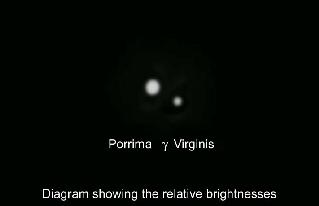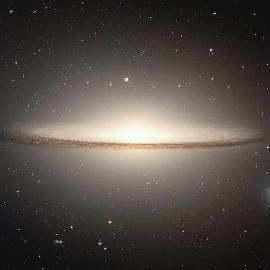Virgo
M87: Virgo A - Galaxy with an Active Galactic Nucleus
Porrima - Double Star
M104 - Sombrero Galaxy
Virgo is large constellation whose brightest star is 1st magnitude Spica but which contains few other bright stars. At the north of the constellation and crossing into Coma Berenices is a region of the sky called the 'realm of the galaxies'. It is in this direction that we are looking towards the centre of our local super cluster of galaxies, the Virgo supercluster of which our small 'local group' of galaxies is an outlying member. Here Messier logged 16 galaxies, and sweeping this region under dark skies is very rewarding. One galaxy from this region is in the A-List along with a second galaxy on the boundary with Corvus. A nice, but currently very challenging, double star system is also in the list. Virgo is highest in the sky from April to June.
M87 Giant Elliptical Galaxy M
M87 is a magnitude 8.6 giant elliptical galaxy - one of the largest galaxies in the universe - lying at a distance of 60 million light years at the centre of the Virgo cluster. There are no bright stars nearby and thus it is not too easy to find. This is compounded by the fact that it is surrounded by other galaxies, though these are a little less bright. It lies on the line between Beta Leonis to the west and Epsilon Virginis to the east and is almost halfway between them just over 10 degrees, about two finder fields of view, from Beta Leonis. If your telescope is equatorially mounted and equipped with an eyepiece whose actual field of view is 1.5 degrees or more, then you can place Epsilon Virginis at the top of the field (with inverted image) and lock the declination axis. (Southern observers: bottom of the field.) Then sweep westwards in right ascension by 31 minutes (7.75 degrees) and M87 should lie towards the bottom (southern: top) of the field. M87 will appear as a roughly spherical fuzzy disc.
M87 is an exceptional galaxy. Though of similar diameter to our own Milky Way galaxy, being spherical rather than just a thin disc in shape, it contains vastly more stars, several trillion in number. Deep exposure photographs show that it extends far beyond the 7 arc minutes shown in most photographs, perhaps to half a degree across. It is surrounded by a swarm of globular clusters. M87 also has a jet visible on short exposure photographs. This jet is an outflow of material ejected from the region of a supermassive black hole at the centre of the galaxy. The jet is the source of intense radio emission and thus M87 is termed a radio galaxy and has been given the name Virgo A.
position: 12h 30.8m +12deg 24min
Porrima - Gamma Virginis Double Star E B H
Porrima is a magnitude 2.7 star lying 10 degrees from Spica in the direct line from Spica towards Beta Leonis - the star at the hindquarters of the lion. The view with a telescope under high power can be stunning: a pair of identical twins, each being type F stars, white in colour, whose surface temperature is about 7000K, somewhat hotter than our Sun. Lying at a distance of 38 light years, they are 50% more massive than our Sun and about 4 times greater in luminosity. The two stars are orbiting each other with a period of 170 years having a separation of 40 AU, about the distance of Pluto from the Sun. Their angular separation in the sky reaches a minimum in 2005 when they will be less than 1 arc second apart making them very difficult to split. You will need a night of excellent seeing and first-class telescope optics to succeed in the next few years! However it will be very worthwhile observing them each coming year as you will gradually observe them moving apart - out to a separation of about 2 arc seconds by 2012. There are very few double stars where one can see significant differences in just a few years! Their maximum separation, of just under six arc seconds, will occur around 2080.
Position: 12h 41.7m -01deg 27min
M104 - The Sombrero Galaxy Galaxy M
M104 is an 8th magnitude type Sa spiral galaxy seen almost edge-on. Type Sa spirals have a prominent nucleus surrounded by tightly wound spiral arms. It lies on almost the same declination as Spica, so centre Spica in the telescope field using a low power eyepiece, lock the declination axis and move westwards in right ascension by 45 minutes (RA is measured in time: 45 minutes corresponds to 11.25 degrees). One can also reach it by moving north and a little east by about one finder- field of view from Delta Corvi. In addition, a line of 7th magnitude stars leads up towards M104 from Gamma Corvi reaching an arrow shaped asterism pointing a little to the west of M104. (See inset on star chart.) As with all galaxies, you really need a dark and transparent sky to observe it well. At low power it appears as a small oval patch of light. With higher powers the brilliant core becomes more obvious and a dark band, due to a prominent dust lane, appears to cross it – this dust lane forming the rim of the Sombrero Hat. Its dimensions are 9 by 4 arc minutes and M104 is thought to lie at a distance of 50 to 60 million light years.
position: 12h 40.0'&nbap -11deg 37min
Other Messier Galaxies.
The region in the circle on the sky with Epsilon Virginis and Beta Leonis at either side (shown on the chart) will reveal a host of galaxies when observing with a well dark-adapted eye under dark skies. Scanning a telescope at medium power should enable you to see many other galaxies in Messier's catalogue. From North to South there are: M85, M100, M98, M91, M88, M99, M90, M86, M84, M89, M87, M58, M59, M60, M49 and M61.






